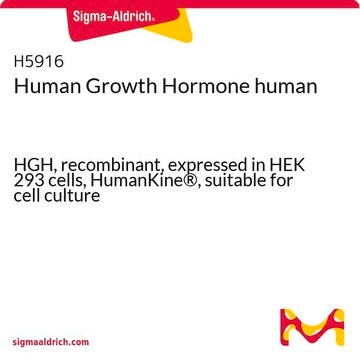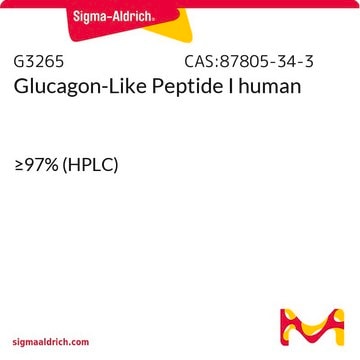S7147
Secretin human
≥97% (HPLC), powder
Scegli un formato
Scegli un formato
About This Item
Prodotti consigliati
Saggio
≥97% (HPLC)
Stato
powder
Temperatura di conservazione
−20°C
Stringa SMILE
CC(C)C[C@H](NC(=O)CNC(=O)[C@H](CCC(N)=O)NC(=O)[C@H](CC(C)C)NC(=O)[C@H](CC(C)C)NC(=O)[C@H](CCCNC(N)=N)NC(=O)[C@H](CCC(N)=O)NC(=O)[C@H](CC(C)C)NC(=O)[C@H](CCCNC(N)=N)NC(=O)[C@H](C)NC(=O)CNC(=O)[C@H](CCC(O)=O)NC(=O)[C@H](CCCNC(N)=N)NC(=O)[C@H](CC(C)C)NC(=O)[C@H](CCCNC(N)=N)NC(=O)[C@H](CO)NC(=O)[C@H](CC(C)C)NC(=O)[C@H](CCC(O)=O)NC(=O)[C@H](CO)NC(=O)[C@@H](NC(=O)[C@H](Cc1ccccc1)NC(=O)[C@@H](NC(=O)CNC(=O)[C@H](CC(O)=O)NC(=O)[C@H](CO)NC(=O)[C@@H](N)Cc2c[nH]cn2)[C@@H](C)O)[C@@H](C)O)C(=O)N[C@@H](C(C)C)C(N)=O
InChI
1S/C130H220N44O40/c1-60(2)43-81(120(208)173-100(66(13)14)103(134)191)153-95(183)54-149-106(194)77(31-35-92(132)180)159-116(204)84(46-63(7)8)166-118(206)85(47-64(9)10)164-111(199)75(29-23-41-146-129(139)140)155-113(201)79(32-36-93(133)181)160-117(205)83(45-62(5)6)162-110(198)73(27-21-39-144-127(135)136)154-104(192)67(15)152-94(182)53-148-107(195)78(33-37-97(185)186)158-109(197)74(28-22-40-145-128(137)138)156-115(203)82(44-61(3)4)163-112(200)76(30-24-42-147-130(141)142)157-122(210)90(57-176)170-119(207)86(48-65(11)12)165-114(202)80(34-38-98(187)188)161-123(211)91(58-177)171-126(214)102(69(17)179)174-121(209)87(49-70-25-19-18-20-26-70)168-125(213)101(68(16)178)172-96(184)55-150-108(196)88(51-99(189)190)167-124(212)89(56-175)169-105(193)72(131)50-71-52-143-59-151-71/h18-20,25-26,52,59-69,72-91,100-102,175-179H,21-24,27-51,53-58,131H2,1-17H3,(H2,132,180)(H2,133,181)(H2,134,191)(H,143,151)(H,148,195)(H,149,194)(H,150,196)(H,152,182)(H,153,183)(H,154,192)(H,155,201)(H,156,203)(H,157,210)(H,158,197)(H,159,204)(H,160,205)(H,161,211)(H,162,198)(H,163,200)(H,164,199)(H,165,202)(H,166,206)(H,167,212)(H,168,213)(H,169,193)(H,170,207)(H,171,214)(H,172,184)(H,173,208)(H,174,209)(H,185,186)(H,187,188)(H,189,190)(H4,135,136,144)(H4,137,138,145)(H4,139,140,146)(H4,141,142,147)/t67-,68+,69+,72-,73-,74-,75-,76-,77-,78-,79-,80-,81-,82-,83-,84-,85-,86-,87-,88-,89-,90-,91-,100-,101-,102-/m0/s1
OWMZNFCDEHGFEP-NFBCVYDUSA-N
Informazioni sul gene
human ... SCT(6343) , SCTR(6344)
Amino Acid Sequence
Descrizione generale
Applicazioni
- in the radioimmunoassay with oxyntomodulin[3]
- to test its effect on the enlargement and swelling of human endoderm stem cells (hEnSCs) derived cyst[4]
- to stimulate human induced pluripotent stem cells (iPSC)-derived biliary cells in cyclic adenosine monophosphate (cAMP) assays to test its effect on cAMP production[5]
Azioni biochim/fisiol
Codice della classe di stoccaggio
11 - Combustible Solids
Classe di pericolosità dell'acqua (WGK)
WGK 3
Punto d’infiammabilità (°F)
Not applicable
Punto d’infiammabilità (°C)
Not applicable
Dispositivi di protezione individuale
Eyeshields, Gloves, type N95 (US)
Scegli una delle versioni più recenti:
Certificati d'analisi (COA)
Non trovi la versione di tuo interesse?
Se hai bisogno di una versione specifica, puoi cercare il certificato tramite il numero di lotto.
Possiedi già questo prodotto?
I documenti relativi ai prodotti acquistati recentemente sono disponibili nell’Archivio dei documenti.
Active Filters
Il team dei nostri ricercatori vanta grande esperienza in tutte le aree della ricerca quali Life Science, scienza dei materiali, sintesi chimica, cromatografia, discipline analitiche, ecc..
Contatta l'Assistenza Tecnica.








